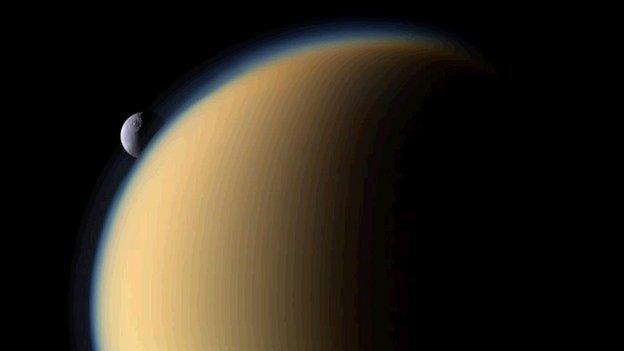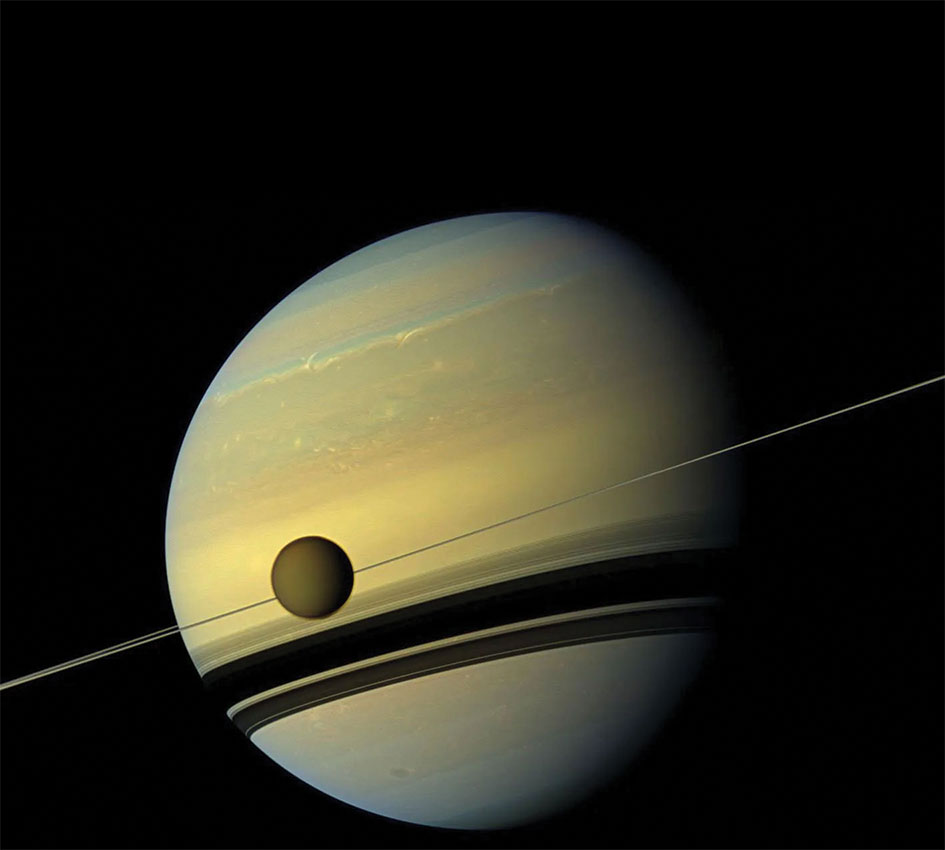When we think about Earth-like worlds, Mars usually comes to mind first. But what if the most Earth-like place in our solar system isn’t a rocky red desert — but a golden, hazy moon orbiting Saturn?
Welcome to Titan moon, a world that mirrors our planet in astonishing ways. With rivers, lakes, and rain, Titan looks eerily familiar — except its “water” is liquid methane and ethane. Scientists believe Titan’s landscape behaves much like Earth’s, shaped by an alien version of the water cycle that replaces H₂O with hydrocarbons. stay with Spaceyv
In this deep dive, we’ll explore Titan’s surface, atmosphere, and methane cycle, understand why it resembles Earth, and discuss whether life could survive in such a frigid, alien world.

🪐 What Is Titan? A Quick Overview
Titan is the largest moon of Saturn and the second-largest in the solar system, after Jupiter’s Ganymede. It’s even bigger than the planet Mercury. Discovered by Christiaan Huygens in 1655, Titan remained mysterious for centuries — until spacecraft like Cassini and Huygens revealed its stunning complexity.
Here are a few key facts:
-
Diameter: 5,150 km (3,200 miles)
-
Surface temperature: ~-179°C (-290°F)
-
Atmosphere: Nitrogen-rich (like Earth’s) with methane clouds
-
Surface pressure: 1.5 times that of Earth
-
Orbit: Around Saturn, every 16 Earth days
What makes Titan moon so extraordinary is that it’s the only place beyond Earth known to have stable liquids on its surface. But instead of water, Titan’s rivers and seas are filled with methane and ethane — hydrocarbons that would instantly vaporize on our planet.
You can also read this Related content
Europa Moon: Could This Hidden Ocean World Harbor Alien Life Beneath the Ice?
🌫️ Titan’s Atmosphere: Thick, Orange, and Alive
Titan’s orange haze is one of its most recognizable features. Its thick atmosphere is mostly nitrogen (95%), just like Earth’s, but it also contains methane (around 5%) and complex organic molecules.
☁️ Why Titan’s Atmosphere Matters
-
It’s denser than Earth’s, meaning humans could theoretically walk on Titan’s surface without a pressure suit (though a warm suit and oxygen tank are still needed).
-
The atmosphere protects the surface from radiation and impacts, allowing stable liquids to exist.
-
Sunlight triggers chemical reactions in the upper atmosphere, forming tholin particles — orange organic compounds that fall like snow, coating Titan’s surface.
This organic chemistry could be a precursor to life, similar to what might have existed on early Earth.
🌊 Titan’s Methane Lakes and Rivers
One of the most remarkable discoveries by the Cassini-Huygens mission (2004–2017) was that Titan has lakes, rivers, and seas filled with liquid methane and ethane.
In the north polar region, Cassini detected large seas — the biggest of which, Kraken Mare, is larger than the Caspian Sea on Earth. Others, like Ligeia Mare and Punga Mare, show distinct shorelines, islands, and even river deltas.
🌧️ Titan’s “Water” Cycle
On Earth, the water cycle involves:
-
Evaporation of water into clouds
-
Condensation into rain
-
Precipitation back to rivers and oceans
On Titan moon, the same process occurs — but with methane instead of water:
-
Methane evaporates from the lakes into Titan’s atmosphere.
-
It forms clouds near the poles.
-
Methane rains back down as liquid, carving valleys and river channels.
This process is called the methane cycle, and it perfectly mimics Earth’s hydrological cycle — making Titan the only other world with active liquid weather.
🧬 NASA scientists call Titan’s methane cycle “a cold mirror of Earth,” where methane plays the same role water does here.
🌍 Titan vs Earth: A Comparison of Two Worlds
| Feature | Earth | Titan |
|---|---|---|
| Main Liquid | Water (H₂O) | Methane (CH₄) & Ethane (C₂H₆) |
| Surface Temperature | ~15°C (59°F) | -179°C (-290°F) |
| Atmosphere | Nitrogen + Oxygen | Nitrogen + Methane |
| Weather Cycle | Water-based | Methane-based |
| Surface Pressure | 1 atm | 1.5 atm |
| Oceans & Rivers | Yes | Yes (Methane) |
| Potential for Life | Confirmed | Possible (Exotic life) |
Even though Titan is freezing, it’s astonishingly Earth-like in process and pattern. Both worlds have erosion, rain, clouds, and landscapes sculpted by liquid flow — making Titan a natural laboratory for studying planetary evolution and habitability.
🔭 How We Discovered Titan’s Lakes and Methane Cycle
🛰️ Cassini-Huygens Mission: The Game Changer
In 2005, the Huygens probe (built by ESA) descended through Titan’s atmosphere, transmitting the first-ever images from the surface. It showed rounded pebbles and dried riverbeds, evidence of past liquid flow.
Then the Cassini orbiter used radar to see through Titan’s thick haze, mapping vast lakes and complex drainage systems. The data revealed:
-
River networks carved into icy terrain
-
Seasonal rainfall near the poles
-
Fog and methane clouds forming near Titan’s surface
📡 How Radar Helped
Since Titan’s dense atmosphere blocks visible light, radar and infrared imaging were crucial. Cassini’s radar could penetrate the haze, showing smooth surfaces where methane seas reflected radio waves — a telltale sign of liquid bodies.
These discoveries transformed Titan from a mysterious orange orb into a living, breathing world with meteorology and geology reminiscent of Earth’s.

🌦️ Seasons and Climate on Titan
Titan experiences seasons, just like Earth, because Saturn’s axis is tilted by about 27 degrees. Each Titan season lasts around 7 Earth years.
During northern summer, methane clouds gather and rainstorms fill the polar lakes. In winter, the southern hemisphere experiences similar activity.
🌤️ Interesting Climate Facts:
-
Titan’s winds sculpt dunes near the equator, made of organic sand grains.
-
Polar regions are wetter, with active rainfall.
-
Equatorial areas are drier, forming methane deserts.
This dynamic climate system makes Titan the only moon with active weather and seasons — a sign of remarkable planetary complexity.
🧬 Could There Be Life on Titan Moon?
Titan’s extreme cold rules out Earth-like life, but exotic forms of life might still exist.
Possible Life Scenarios:
-
Life in the Surface Lakes
Scientists hypothesize methane-based microbes — “methanogens” — could use hydrogen and acetylene as energy sources.
On Earth, some bacteria already metabolize methane, proving such chemistry is possible. -
Life in a Subsurface Ocean
Beneath Titan’s icy crust may lie a hidden ocean of water mixed with ammonia. If true, it could harbor microbial life similar to that suspected on Europa or Enceladus. -
Organic Chemistry in the Atmosphere
Titan’s upper atmosphere creates complex organic molecules — possible precursors to amino acids. This makes Titan a natural lab for prebiotic chemistry, helping scientists understand how life might begin elsewhere.
“Titan is like a frozen version of early Earth,” says Dr. Sarah Hörst, a planetary scientist at Johns Hopkins University. “It’s a time capsule showing how life’s building blocks could form naturally.”
The Future of Titan Exploration
The next big leap in exploring Titan is NASA’s Dragonfly Mission, launching in 2028 (arriving ~2034).
🪰 What Is Dragonfly?
Dragonfly is a nuclear-powered rotorcraft — essentially a flying drone — that will hop across Titan’s surface, analyzing soil, atmosphere, and organic materials.
Its mission goals include:
-
Searching for chemical signatures of life
-
Studying methane weather patterns
-
Sampling organic dunes and icy plains
-
Measuring surface composition and radioactivity
Dragonfly will explore Titan’s Shangri-La dune fields and possibly fly near Selk Crater, where water and organics may have mixed — a perfect spot to search for life’s precursors.
💡 Why Titan Is So Important to Science
Titan is a world that blurs the line between familiar and alien.
It teaches us that Earth’s processes aren’t unique — they can occur elsewhere with different materials and temperatures.
🌌 Scientific Significance:
-
Astrobiology: Titan helps us explore how life could exist without water.
-
Climate Science: Its methane cycle offers insight into atmospheric evolution.
-
Comparative Planetology: Studying Titan helps scientists understand Earth’s history and potential exoplanet habitability.
🧭 Key Takeaways
-
Titan moon is Saturn’s largest and most Earth-like satellite.
-
It has lakes, rivers, and rain — made of liquid methane and ethane.
-
Titan’s methane cycle mirrors Earth’s water cycle, creating weather, erosion, and lakes.
-
It’s a prime target for astrobiology, offering clues about life in extreme conditions.
-
Future missions like NASA’s Dragonfly will explore its surface in unprecedented detail.
🧩 Trusted Sources & References
-
NASA Titan Overview:
https://solarsystem.nasa.gov/moons/saturn-moons/titan/overview/ -
Cassini–Huygens Mission Results (NASA JPL):
https://saturn.jpl.nasa.gov -
Dragonfly Mission (NASA Official):
https://dragonfly.jhuapl.edu
Final Thoughts
The Titan moon proves that even in the cold reaches of Saturn’s orbit, nature finds a way to repeat itself.
It shows us that rivers, rain, and weather aren’t exclusive to Earth — they’re part of the cosmic rhythm that might exist across countless worlds.
As Dragonfly prepares to soar across Titan’s alien skies, humanity moves one step closer to answering one of our oldest questions:
Are we truly unique, or is life a natural outcome wherever chemistry, atmosphere, and time intertwine?



